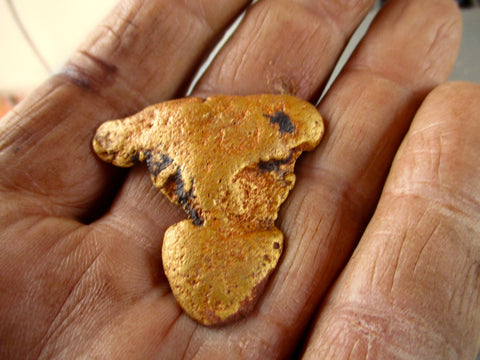Finding new patches of gold was a popular topic around the campfire and ideas were beginning to develop into a plan that would hopefully see the three hardened bushies with a swag full of bounty each. Every year reports filter through of a lucky prospector finding a decent size nugget in the Western Australian Goldfields but the chances of this happening are slight as most of the alluvial ground has been worked pretty hard over the last 20 years.
During the gold rush period pre 1900 reports have it that many prospectors specked gold in large quantities, 10 – 15 ounces a day whilst travelling from one gold field to the next and there are still sun bakers as we call them to be found but are small and generally picked up by detecting them.
Finding new alluvial ground is difficult and the prospector needs to push further out east and north into pretty harsh waterless country so the average jo blo from the eastern states is not the right person for this country and many who tried have found themselves in serious trouble with break downs or getting lost and in some cases resulting in death.

The bushies, Rod, Larry and Jake have spent many years in the goldfields as prospectors, dry blowers or pushing country and live there year round regardless of the extreme conditions and have developed a healthy respect for the country that can so easily have you in serious trouble.
Having discussed all the potential hazards the boys were finally getting down to a solid plan of attack and just waiting on the cooler weather which should be only weeks away. Once the temperature is down to 34 during the day then the going becomes easy, over that puts stress on everybody and the vehicles.
Wiluna was the departure point to the so called badlands or desert and sand dunes country. The shifting sands were the object of the exercise revealing new country as they moved slowly by the prevailing south westerly winds.
There are a number of large gold mines in the desert, open cut and deep down into gold bearing rock but generally over this on the surface alluvial gold can be found, and that’s what the boys were after.

With a Toyota Landcruiser each and quad bikes loaded and extra water fuel and beer stacked wherever space was available the boys set out on a station track due east of Wiluna to some breakaway country which was a fault line running north west to south east. This country is always worth detecting but can be difficult to cross and sometimes many k’s have to be covered to get around the face and back onto the line east to the sand dune country. The boys camped below the escarpment and put in two solid days working the western side of the breakaway. Signs of previous prospectors work could be seen by dig holes which led to gold being found but mostly small nuggets below 3 or 4 grammes. It was a good start and the boys reckoned the small finds would cover the beer costs for the trip if nothing else.
Recent storms had filled 4 substantial gnamma holes found along the top of the breakaway and camel camps were seen close by in the mulga with pads leading to the east. The dingoes had been about as well leaving tracks along dry creek beds but none were seen as is mostly the case in this country however, at night we could hear them howling and sounded close by as you laid in the swag by the fire at night. Jakes red healer dog replied to the howls with some ferrousish barking making sure the camp remained safe during the night.
Having worked the area pretty well the boys decided to push on east to see what the country offered further out. This is real desert country, plenty of mulga and snakewood growing on the hardest ironstone ground and desert oaks growing in the lighter soils where runoff occurs after storms. The olive coloured follage unique to this harsh environment is broken only by the soft light green follage of the emu bush or desert currajong. If you stand beside such a tree with your left hand on the rough side and right on the smooth side then you should be facing north, a bush compass so to speak.

We started to cross small sand dunes and between them rubble of quartz and ion stone which there is plenty of through the gold fields but that mixture on its own generally doesn’t mean gold. We were after a similar mix that came off old hills or ridges which now maybe only a few feet high and weathered down over the period from the last ice age with the receding water shifting gold to points near where the ridges formed small gullies as traps for rocks and gold washed by faster flowing water, sometimes these areas can be over a kilometre from the barley decreeable hill or ridge so it takes some imagination to piece all this together and still not find gold.
We headed to some higher ground a few k’s to the south of our easterly line and looked forward to what mix of rocks we would find, the sand dunes we travelled between were petering out as we approached the small line of hills or higher ground. It looked good, a laterite ridge with ion stone and quarts blows running to the west so a camp was made and the quad biked unloaded so we could work the rather large area.
Rod was what we call the “hill man” of the camp, he liked to work the hardest sections where few people go and found many nuggets on top of hills that stayed put during the weathering process rather than shedding down a slope. He also had many good finds between to peaks in what we call the saddle. The challenges of finding gold can put you under pressure and the scale of the area and the many possibilities of where the run would start or get to is endless as you try and piece together in your mind what occurred millions of years ago.

Some prospectors just strap the gear on and head off without a plan and hope they walk over one but at the end of the day his report cannot declare that the area worked is free of gold. There really needs to be a plan of the most likely areas and then start a loose grid of the slope of ridge covering probably 30% of the area. If gold is found then that area is worked slowly and carefully until the run has been finished. What we call the prickly gold with small sharp points indicates the gold hasn’t moved far from the original shedding whereas the gold with a smoothe surface is water worn and shifted a considerable distance so in that case working the areas below and above can yield more nuggets.
The results for the day by all had been good with over an ounce coming in between the three so it looked like the camp would be permanent for at least a week as the slopes were chained so as not to miss any ground and once worked a clear sign remaining so no further work was needed. The week resulted with 7 ounces, the boys were was happy but reckoned they would have found bigger gold as he largest piece weighed in at 20 grammes.
Back on the move further east looking for signs of a change in the terrain took a day without any result so an over night camp and back behind the wheel again the following day through some pretty tough country of mulga and spinafex. Finally some higher ground appeared north of our line so we headed that way but soon came to steep banked creek beds we were unable to cross. This diversion took up the balance of the day but we finally arrived and made camp on the ironstone flat west of the ridge.

This country looked pretty good and a huge area to work so the quad bikes were unloaded and a more permanent camp set up. Next morning the boys headed off in 3 separate directions with plenty of water and tucker on board in case of a breakdown. Sat phones are standard for safety as well as a GPS and a PLB, personal locator beacon. Nobody wants to use these safety devises but they are standard equipment especially in remote areas.
The boys returned during the afternoon and soon had a cold beer out and a fire going with enough coals to cook a roast in the camp oven. Everybody found gold but Jake topped the leader board with 1.45 ounces, altogether they found 2.5 so a pretty good days work and hopefully more to come. There was plenty of optimistic talk about the fire that night and they headed off to their swags early ready for plenty of hard work the following day.
This ground was right on the edge of the sand dune country which could be seen from the ridge stretching out east to the horizon, not a road or track for probably 1000 k’s in that direction and probably no water apart from the odd gnamma hole.
During the next four days they all found gold but it was getting harder and they decided to work closer to camp and move on if no gold was found. About eleven in the morning Larry let out a woop and a cooee to call the boys over. He just found a big slug, looked to be about four ounces and he had dug a fair size hole and there were still signals coming from the hole. The other boys grabbed a bar and shovel from the camp and they all agreed to share whatever came out but not counting the four ouncer.
They took turns on the bar and shovel and spread the dirt out nearby so it could be detected and the gold kept coming. These are called glory holes and every now and again you hear of people finding them so it’s always worth while checking the hole gold came out of incase there is more. They threw the gold into a panning dish and kept digging and the gold kept coming. Three times the hole was widened so the work could continue down as the ground was hard as hell and plenty of big quarts rocks to pick up and lift out After 4 hours hard work the gold cut out so the boys had a weigh up and they cracked just over ninteen ounces. The beers tasted pretty good that night and talk of gold went on late into the evening.

Next morning they reckoned the trip was over and decided to head back to the breakaway country south east of Laverton closer to civilisation and would then draw straws for one of them to head to Kalgoorlie and sell the gold. Another successful trip and there would soon be plans talked about where to head next.
